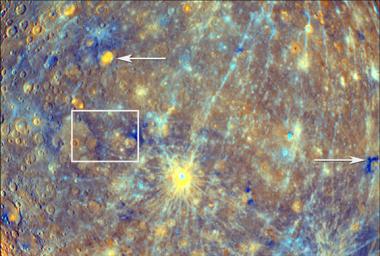This color context image shows equatorial regions on the side of Mercury seen during MESSENGER’s departure from Mercury on October 6, 2008. Mercury’s true colors are very subtle (see PIA11364), but statistical methods can take advantage of the ability of MDIS to take pictures in 11 narrow color bands spread across visible and near-infrared wavelengths (400 to 1050 nm). Such methods greatly enhance subtle color differences in the materials at Mercury’s surface, providing insight into the compositional variations present on Mercury and the geologic processes that created those color differences. The bright yellow halo around Kuiper crater (62 kilometers (39 miles) in diameter; just below center) stands out as bright and colorful mostly because of its young age (see PIA11355). When the crater was formed, material from beneath the surface was ejected outwards and formed the bright surrounding blanket. As time passes, this young material will suffer micrometeorite impacts and the ravages of solar wind bombardment and will gradually become darker and redder. Several hundred million years from now, Kuiper’s distinctive rays will fade into the background. The wispy blue linear features are rays from distant young impact craters. The bright orange material (left arrow) in the floor of Lermontov crater (152 kilometers (94 miles) in diameter) was most likely deposited by volcanic eruptions in Mercury’s distant past. A mysterious dark bluish material is seen in many places on Mercury, and new data from the second flyby reveal a small area with a high concentration (right arrow) (see PIA11357). Once MESSENGER goes into orbit about Mercury, its full complement of instruments will examine these diverse locations and help unravel the processes that accompanied formation and later modification of Mercury’s crust. North is up for this image, and the white box indicates the boundaries of a close-up view of a portion of this scene (see PIA11410).
Date Acquired: October 6, 2008
Instrument: Wide Angle Camera (WAC) of the Mercury Dual Imaging System (MDIS)
Scale: The width of this scene is about 4,000 kilometers (2,500 miles)
These images are from MESSENGER, a NASA Discovery mission to conduct the first orbital study of the innermost planet, Mercury. For information regarding the use of images, see the MESSENGER image use policy.

 Planetary Data System
Planetary Data System












